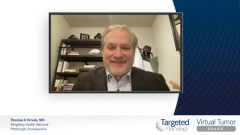
Case 1: Using Niraparib Maintenance Therapy in Ovarian Cancer
Cecelia H. Boardman, MD, John K. Chan, MD, and Thomas C. Krivak, MD, provide insight on dosing schedules for niraparib maintenance in advanced ovarian cancer.
Episodes in this series

Thomas C. Krivak, MD: A decision with this patient with a BRCA2 mutation, optimally debulked, talking through all the data, is decided to go ahead and start this patient, about 10 to 12 weeks after her completion of her chemotherapy, on niraparib [Zejula]. Looking at her weight, the fact that she was right around 63 kilos, 140 pounds, it’s important that we talk about the weight-based dosing, the platelet-based dosing, that this patient was started at 200 mg once a day in the evening.
Again, looking at the phase 3 PRIMA trial, what it did show is that obviously these patients were randomized between niraparib and placebo. We talked about that when we had seen the other slides, that it showed some of the similarities, but differences among trials. But within the NOVA trial, they tried to tease out what may be some risk factors for thrombocytopenia, and then they applied those into the phase 3 PRIMA trial. What they found was patients who were under 77 kilos or had platelets under 150 mcL at starting, could be started at an individualized dose, and that would be 200 mg once a day instead of 300 mg once a day. You can see down there with respect to HRD [homologous recombination deficiency] tumors in overall, the responses in the hazard ratios, you can see there that they still had a statistically significant hazard ratio with 0.5 in the HRD patients as well as 0.65 in the overall population. Even though you may be starting at a lower dose, you decrease the adverse effect profile and you maintain a nice hazard ratio and response.
With respect to Dr Boardman, what do you think about the individualized dose versus the fixed dose, and how about managing some of the adverse effects with respect to niraparib?
Cecelia H. Boardman, MD: I certainly have found that with the individualized dosing, I personally see a lot less grade 3/grade 4 thrombocytopenia. The other thing that I learned as I used this drug is that those weekly lab assessments during that first month on therapy are so important. I don’t wait for the patient to develop a grade 3/grade 4 thrombocytopenia prior to dose interruption. If I see any decrease in the platelets, even a grade 1, I will dose interrupt and then wait for that platelet count to return to the normal range and then dose reduce 1 dose level for the management of the thrombocytopenia.
I also find that in general with PARP inhibitors, dose interruption is a helpful management strategy. If my patient is experiencing dyspnea or tachycardia or fatigue or nausea, 1 helpful strategy is dose interruption. Give them a little break, give them a week, give them 2 weeks, allow those symptoms to resolve or to improve, and reintroduce them at the same dose and they often tolerate the drug better the second time with a little break. The dose interruption is a very important strategy in maintaining the ability of the patient to be compliant and stay on treatment.
Nausea is also important, to make the patients aware that it is perfectly appropriate to coadminister a 5HT3 [serotonin] along with their PARP inhibitor to prevent nausea. We certainly provide our patients with prescriptions for a 5HT3 so that they have that flexibility to manage that nausea if that does occur. I find particularly with niraparib, which is once-daily dosing, that evening or bed-time dosing, as you mentioned previously, is another effective strategy for managing nausea associated with the drug. They basically sleep through it, and they don’t experience much, and they don’t need the 5HT3 and they wake up in the morning and they feel well. You have a small percentage of patients who find that niraparib actually keeps them awake at night. For those patients who have insomnia associated with it, I go back to morning dosing. But the majority of my patients, I do evening dosing and then 5HT3 PRN as needed.
Thomas C. Krivak, MD: John? Any thoughts?
John K. Chan, MD: That’s a very nice summary, Cecelia. The only thing I would reiterate everything that you said. I reschedule the medicine, because it’s a 1-time dosing, in the evening, when the drug adverse effect peaks, whether it’s nausea or fatigue, they’re resting through it. The second thing that is really important is to reassure the patients that most of their adverse effects associated with these compounds are going to be in the first 2 or 3 months. Unlike chemotherapy, where the adverse effects are cumulative over time, the adverse effects of these drugs are more front loaded. If you can help them manage these adverse effects based on what we were talking about, this helps to reassure the patients that this is not going to be long term.
The second or third thing that I would just reiterate what Cecelia talked about is you can rest these patients. Give them a break from 1 to 4 weeks on this trial. We have our nurses or we check back with them, after a week of break, 2 weeks of break, 3 weeks of break, recheck their labs and see if we can restart the medicine. Then the only thing I would add to Cecelia, what I do is when I restart the medicine, I go on a slower ramp up. I don’t restart them at 300 mg or 200 mg. I may restart them slowly at 100 mg per week, and then next week I give to 200 mg, or I do 1-2-1-2 pill and I slowly ramp them up over the next 3 weeks, see if they can tolerate the drug better. If I can’t get them up to the dose that I like, whether it’s the weights and plates dosing or the full dosing, I back off, which is the dose reduction for these patients. With that approach, with the pre-medications, with the reassurance, with managing the scheduling and restarting and ramping up and reduction, with all these things, we can get better than what these trials have been able to do in terms of lowering the discontinuation rates.
Thomas C. Krivak, MD: What I think is fantastic is how you guys are approaching this and really, it’s keeping these patients on the medication for long term. Let’s figure out how to best do that. Just how you were talking about it, Cecelia, and how you were talking about it, John, the underlying tone is keep them on this medication for a long period of time, 2, 3 years if it’s upfront. And if it’s recurrent, we know they may need to be longer. That’s how important they are. I do completely agree that there’s almost like this tachyphylaxis effect, that the first 2 to 3 months are going to be the worst, and then the patients will be able to tolerate this much, much better. OK. Great discussion, guys. Great discussion.
Again, this is a slide that summarizes some of the weights and plates based data, 300 mg, the fixed dose, the individualized dose starting at 200 mg. Again, Dr Chan, you brought up a really great point about going 100 mg, 200 mg, 300 mg. Some patients that may be homologous recombination proficient that you want to keep them at a higher dose, start them at 200 mg and see how they do, and then potentially go up to 300 mg is completely reasonable. What we can see here is that the PFS [progression-free survival] and the hazard ratios are, for the most part, maintained in these groups of patients.
Again, she was initiated on 200 mg, blood counts done weekly, just like we talked about with Dr Boardman, and again monthly thereafter, and again monitoring blood pressures as well at times for these patients to make sure that their medication is being delivered safely.
Transcript Edited for Clarity











































